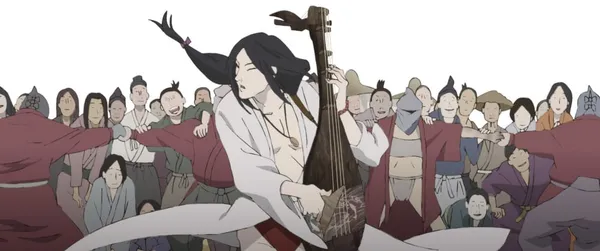Eye For Film >> Movies >> Inu-oh (2021) Film Review
Inu-oh
Reviewed by: Jennie Kermode

Winner of the Satoshi Kon Award for best Animated Feature at this year’s Fantasia International Film Festival, Masaaki Yuasa’s film has almost instantly attained a cult following. Drawing on stories told about a real historical figure, it address key developments in early Noh theatre and explores the reasons why some artists risk everything to tell forbidden stories in the face of aggressive government censorship. It is cleverly animated, intelligent and full of passion. Unfortunately, its mingling of the repetitive musical style of Noh with modern metal riffs, whilst it seems to please some viewers, will leave others wanting to scream for all the wrong reasons.
People scream at Inu-ô (voiced by Queen Bee singer Avu-Chan) when they see his face. He has no name them, born deformed, cast out to be raised by dogs, hiding his head inside a gourd from which eyes look out at the wrong angles. With scales and fur and unnaturally long arm – all fairly common yokai traits – he appears to be cursed (a common assumption made about disabled people in that historical period), but it takes him many years to figure out why, and to do so he needs help – something which has not been easy to obtain. It arrives, eventually, in the form of Tomona (Mirai Moriyama), a blind young biwa player who befriends him and helps him to develop a theatrical, musical show which will allow them both to pursue their ambitions and set right some of the wrongs of the past.
There’s a lot going on here, as the film addresses the harsh political climate of the time and, whilst paying tribute to those who resist censorship, also explores issues around which stories survive, the importance of selling them successfully to a jaded public, and the political risks involved in trying to restrict the flow of ideas, which has often been blamed for stagnating cultural development at a vital point in Japan’s history, leaving it disadvantaged later in comparison to other nations. It also draws on the commonplace theme in Noh of a deformed character becoming more conventionally human as he atones for past sins (which he may have committed in a past life, or may have been committed by his ancestors) or frees himself from a curse – a way of thinking which has helped to perpetuate negative ideas about disabled people.
The use of masks is fundamental to Noh, and viewers familiar with the art will be expecting a big revelation at the end, when unmasking traditionally occurs, but Inu-ô’s gradually transformation means that we can’t be sure what we will see if or when this occurs, and Masaaki’s film also has another trick up its sleeve where this is concerned. Whilst the film borrows from traditional Noh structure, and even has elements of an oni mono, however, it retains a degree of freedom, playing with the form and moving beyond it in a way which mimics the artistic boundary-breaking of its central character. This enables Masaaki to step back from time to time and look at the whole thing in a larger context, as well as weaving in elements early on which may appear to belong to separate adventures but eventually make sense as parts of the whole.
Inu-ô’s success is due only in part to the righteousness of his cause, having rather more to do with his magnificent stagecraft. Masaaki has diligently recreated the Noh stages of the period, but goes beyond them as we see Inu-ô utilise the structures of assorted public spaces to put on his one-time-only plays. The technology of the time is brought to bear in impressive ways and, aside from Inu-ô’s curious body (aspects of which one might think he wouldn’t want to lose), everything seems to obey the laws of physics. This demonstrates Inu-ô’s craft and makes the film much more interesting than yet another tale in which the protagonist is only noteworthy due to supernatural powers. Whilst the supernatural has a place here, it operates within strict limitations – what we get is something very much grounded in reality as contemporary audiences would have understood it.
Adding to the impression created by these scenes are Masaaki’s marvellously detailed depictions of crowds. Whilst they never distract from the main events, if you pay attention you will see all sorts of things going on within them. They feel as if they constitute collections of real individuals, and this contributes to what the film has to say about popularity, power, and the reasons why rulers can feel intimidated by the arts.
There is a great deal here to admire, and clearly some viewers have fallen in love with the soundtrack too. Be warned, though – if you don’t, then for all its artistry, this can be an excruciating experience.
Reviewed on: 07 Aug 2022

















